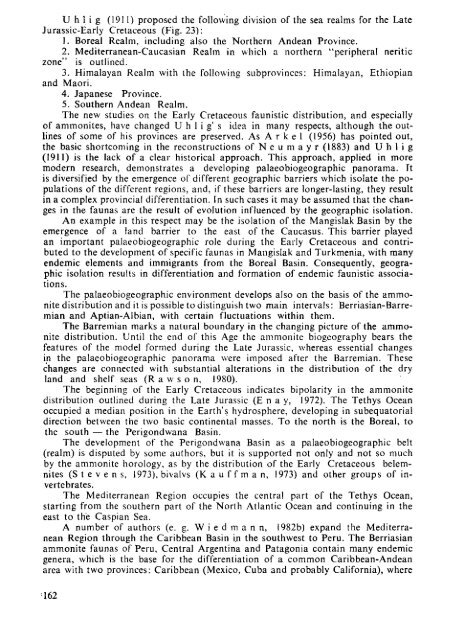THE MEDITERRANEAN LOWER CRETACEOUS
THE MEDITERRANEAN LOWER CRETACEOUS
THE MEDITERRANEAN LOWER CRETACEOUS
Create successful ePaper yourself
Turn your PDF publications into a flip-book with our unique Google optimized e-Paper software.
U h 1 i g (1911) proposed the following division of the sea realms for the Late<br />
Jurassic-Early Cretaceous (Fig. 23):<br />
1. Boreal Realm, including also the Northern Andean Province.<br />
2. Mediterranean-Caucasian Realm in which a northern "peripheral neritic<br />
zone" is outlined.<br />
3. Himalayan Realm with the following subprovinces: Himalayan, Ethiopian<br />
and Maori.<br />
4. Japanese Province.<br />
5. Southern Andean Realm.<br />
The new studies on the Early Cretaceous faunistic distribution, and especially<br />
of ammonites, have changed U h 1 i g' s idea in many respects, although the outlines<br />
of some of his provinces are preserved. As A г к e 1 (1956) has pointed out,<br />
the basic shortcoming in the reconstructions of N e u m а у г (1883) and U h 1 i g<br />
(1911) is the lack of a clear historical approach. This approach, applied in more<br />
modern research, demonstrates a developing palaeobiogeographic panorama. It<br />
is diversified by the emergence of different geographic barriers which isolate the populations<br />
of the different regions, and, if these barriers are longer-lasting, they result<br />
in a complex provincial differentiation. In such cases it may be assumed that the changes<br />
in the faunas are the result of evolution influenced by the geographic isolation.<br />
An example in this respect may be the isolation of the Mangislak Basin by the<br />
emergence of a land barrier to the east of the Caucasus. This barrier played<br />
an important palaeobiogeographic role during the Early Cretaceous and contributed<br />
to the development of specific faunas in Mangislak and Turkmenia, with many<br />
endemic elements and immigrants from the Boreal Basin. Consequently, geographic<br />
isolation results in differentiation and formation of endemic faunistic associations.<br />
The palaeobiogeographic environment develops also on the basis of the ammonite<br />
distribution and it is possible to distinguish two main intervals: Berriasian-Barremian<br />
and Aptian-Albian, with certain fluctuations within them.<br />
The Barremian marks a natural boundary in the changing picture of the ammonite<br />
distribution. Until the end of this Age the ammonite biogeography bears the<br />
features of the model formed during the Late Jurassic, whereas essential changes<br />
in the palaeobiogeographic panorama were imposed after the Barremian. These<br />
changes are connected with substantial alterations in the distribution of the dry<br />
land and shelf seas (R a w s о n, 1980).<br />
The beginning of the Early Cretaceous indicates bipolarity in the ammonite<br />
distribution outlined during the Late Jurassic (E n a y, 1972). The Tethys Ocean<br />
occupied a median position in the Earth's hydrosphere, developing in subequatorial<br />
direction between the two basic continental masses. To the north is the Boreal, to<br />
the south — the Perigondwana Basin.<br />
The development of the Perigondwana Basin as a palaeobiogeographic belt<br />
(realm) is disputed by some authors, but it is supported not only and not so much<br />
by the ammonite horology, as by the distribution of the Early Cretaceous belemnites<br />
(Stevens, 1973), bivalvs (K a u f f m a n, 1973) and other groups of invertebrates.<br />
The Mediterranean Region occupies the central part of the Tethys Ocean,<br />
starting from the southern part of the North Atlantic Ocean and continuing in the<br />
east to the Caspian Sea.<br />
A number of authors (e. g. Wiedmann, 1982b) expand the Mediterranean<br />
Region through the Caribbean Basin in the southwest to Peru. The Berriasian<br />
ammonite faunas of Peru, Central Argentina and Patagonia contain many endemic<br />
genera, which is the base for the differentiation of a common Caribbean-Andean<br />
area with two provinces: Caribbean (Mexico, Cuba and probably California), where<br />
162

















